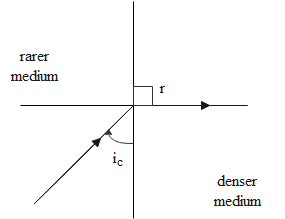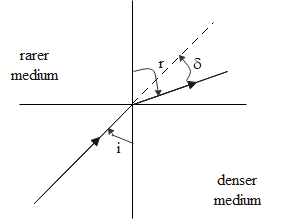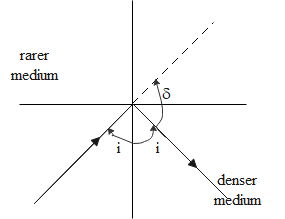
A ray of light travels from an optically denser to rarer medium. The critical angle for the two media is C. The maximum possible deviation of the ray will be
$
{\text{A}}{\text{. }}\dfrac{\pi }{2} - C \\
{\text{B}}{\text{. }}2C \\
{\text{C}}{\text{. }}\pi - 2C \\
{\text{D}}{\text{. }}\pi - C \\
$
Answer
572.7k+ views
Hint: First, we need to draw ray diagrams for a ray of light travelling from denser to rarer medium considering critical angle and total internal reflection. The maximum deviation will occur in case of total internal reflection when angle of incidence is greater than the critical angle.
Complete step by step answer:
The critical angle of a medium can be defined as the angle of incidence of a light ray in the denser medium which is such that the angle of refraction obtained is equal to 90$^\circ $. This can be represented as shown in the figure.

Now consider a general case where we have light ray travelling from a denser medium to a rarer medium at an angle of incidence i and let r be the angle of refraction. The deviation produced in the angle of the light when it passes from the denser medium to rarer medium is equal to difference between the angle of refraction and the angle of incidence. Let the deviation be $\delta $ then it is given as
$\delta = r - i$

Now if $i = C$ (the critical angle) then $r = \dfrac{\pi }{2}$. In this case, the deviation is given as
$\delta = \dfrac{\pi }{2} - C$
The maximum deviation in the light ray will occur when the light will go internal reflection. In case of reflection, the angle of incidence is equal to the angle of reflection.

In this case, the deviation produced is given as
$\delta = \pi - 2i$
Now the deviation is maximum when the value of i is minimum which occurs when $i = C$. Therefore, the maximum deviation possible is
$\delta = \pi - 2C$
So, the correct answer is “Option C”.
Note: It should be noted that total internal reflection occurs when the value of angle of incidence is greater than the critical angle for that medium. This is the reason why the minimum possible value of i is equal to the critical angle.
Complete step by step answer:
The critical angle of a medium can be defined as the angle of incidence of a light ray in the denser medium which is such that the angle of refraction obtained is equal to 90$^\circ $. This can be represented as shown in the figure.

Now consider a general case where we have light ray travelling from a denser medium to a rarer medium at an angle of incidence i and let r be the angle of refraction. The deviation produced in the angle of the light when it passes from the denser medium to rarer medium is equal to difference between the angle of refraction and the angle of incidence. Let the deviation be $\delta $ then it is given as
$\delta = r - i$

Now if $i = C$ (the critical angle) then $r = \dfrac{\pi }{2}$. In this case, the deviation is given as
$\delta = \dfrac{\pi }{2} - C$
The maximum deviation in the light ray will occur when the light will go internal reflection. In case of reflection, the angle of incidence is equal to the angle of reflection.

In this case, the deviation produced is given as
$\delta = \pi - 2i$
Now the deviation is maximum when the value of i is minimum which occurs when $i = C$. Therefore, the maximum deviation possible is
$\delta = \pi - 2C$
So, the correct answer is “Option C”.
Note: It should be noted that total internal reflection occurs when the value of angle of incidence is greater than the critical angle for that medium. This is the reason why the minimum possible value of i is equal to the critical angle.
Recently Updated Pages
Master Class 12 English: Engaging Questions & Answers for Success

Master Class 12 Business Studies: Engaging Questions & Answers for Success

Master Class 12 Economics: Engaging Questions & Answers for Success

Master Class 12 Social Science: Engaging Questions & Answers for Success

Master Class 12 Maths: Engaging Questions & Answers for Success

Master Class 12 Chemistry: Engaging Questions & Answers for Success

Trending doubts
What are the major means of transport Explain each class 12 social science CBSE

Which are the Top 10 Largest Countries of the World?

Draw a labelled sketch of the human eye class 12 physics CBSE

Explain sex determination in humans with line diag class 12 biology CBSE

The pH of the pancreatic juice is A 64 B 86 C 120 D class 12 biology CBSE

Explain sex determination in humans with the help of class 12 biology CBSE




